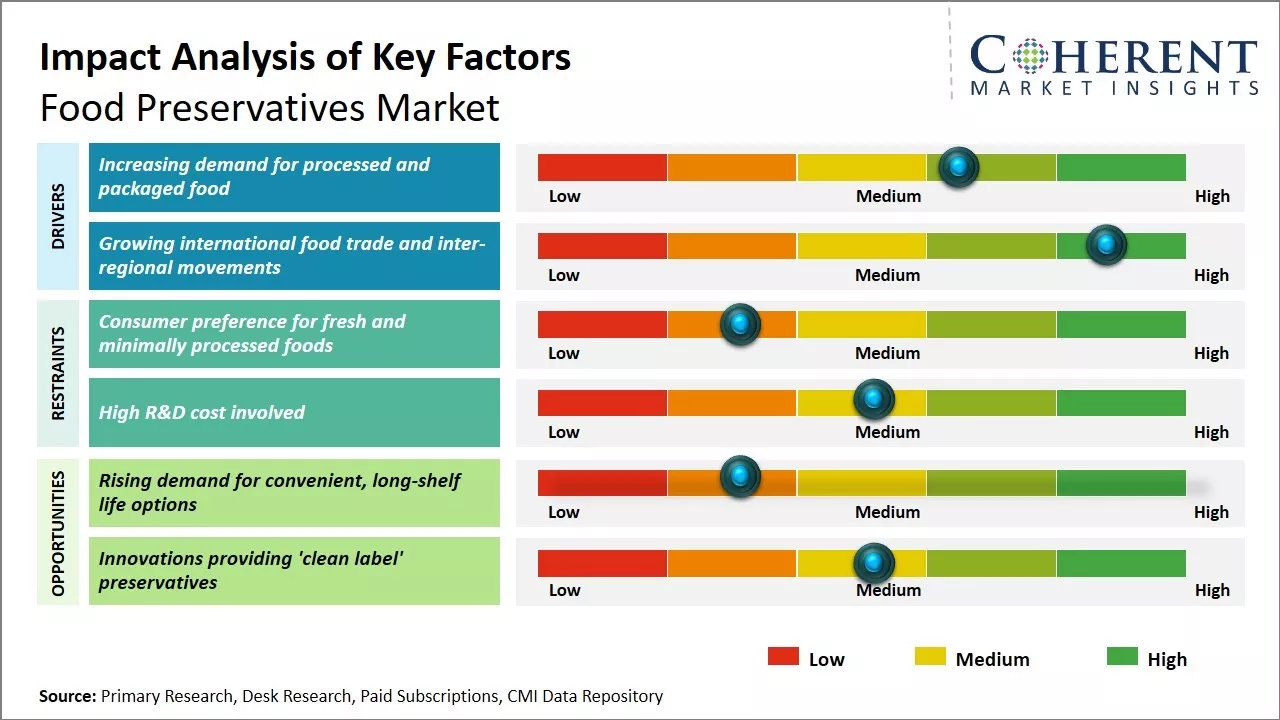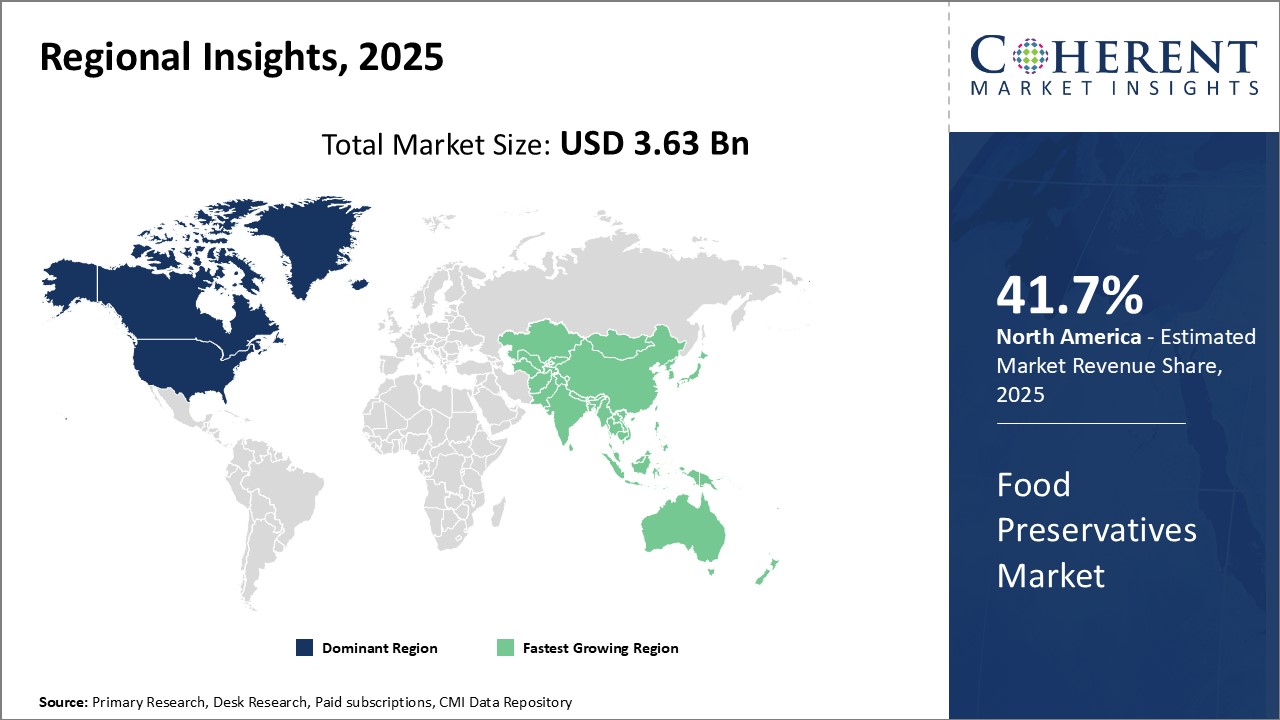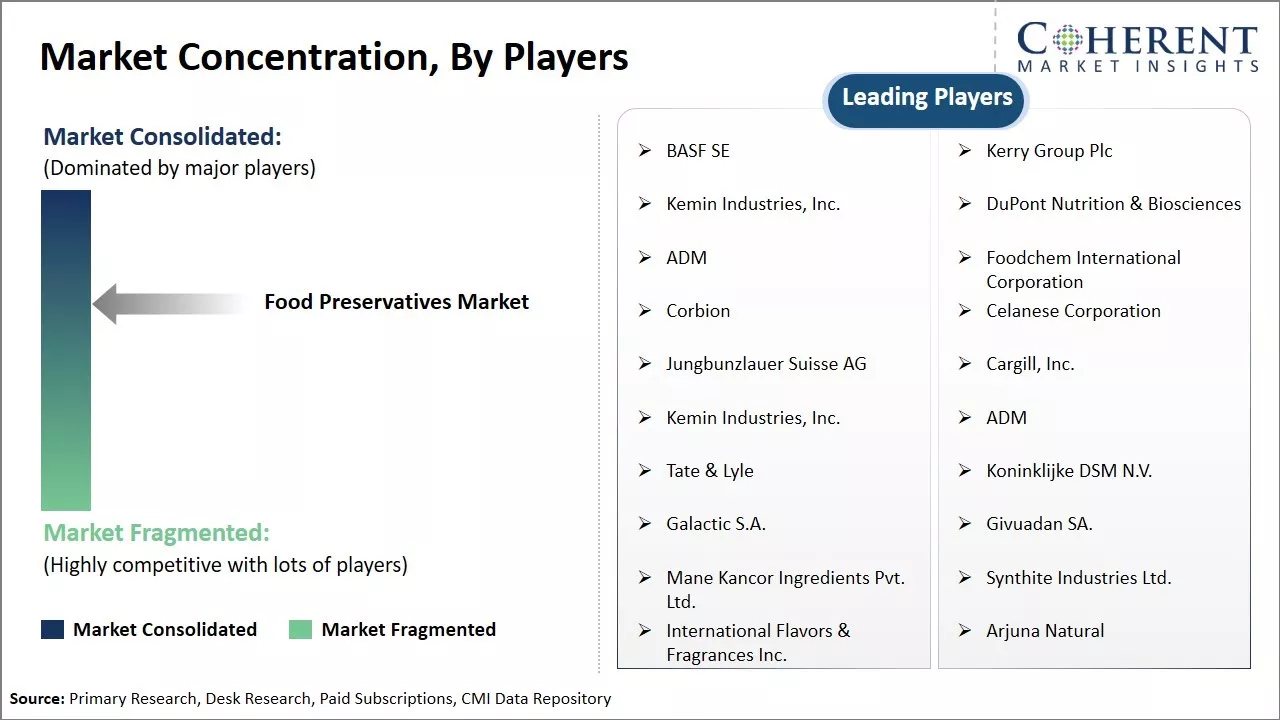Global food preservatives market is estimated to be valued at USD 3.63 Bn in 2025 and is expected to reach USD 5.01 Bn by 2032, exhibiting a compound annual growth rate (CAGR) of 4.7% from 2025 to 2032.

To learn more about this report, Download Free Sample
Concerns around food safety and increasing demand for processed and packaged food items are expected to drive the food preservatives market growth. The market is expected to witness significant growth over the forecast period. Factors such as increasing demand for frozen and processed food products due to changing lifestyles and busier routines will support the increased use of food preservatives. Growing food industries and improving standards of food safety and quality are expected to drive the food preservatives market growth during the forecast period.
|
Current Event |
Description and its Impact |
|
Global Regulatory Transition Toward Natural and Clean Label Preservatives |
|
|
Food Safety Crisis and Antimicrobial Resistance Driving Innovation |
|
Uncover macros and micros vetted on 75+ parameters: Get instant access to report
These are ideal for meat, seafood, and ready meals, as seen in Galactic’s new facility in China.
In terms of source, the natural segment is estimated to contribute 61.7% of the food preservatives market share in 2025. This shift is largely driven by growing consumer awareness around health and wellness, as well as increasing demand for clean-label and organic food products.
Natural preservatives such as vinegar, rosemary extract, and essential oils are favored for their perceived safety and minimal chemical processing. While synthetic preservatives like benzoates, sorbates, and nitrates still hold a significant share due to their cost-effectiveness and broad-spectrum efficacy, regulatory scrutiny and changing consumer preferences are propelling the growth of natural alternatives. As food manufacturers respond to these trends, the natural segment is expected to continue expanding rapidly, outpacing synthetic options in both volume and value.
For instance, in June 2025, Chinova Bioworks, a Fredericton-based company, developed an all-natural food preservative derived from mushrooms, offering a clean-label alternative to synthetic additives like sodium sorbate and sodium benzoate. This innovation supports growing consumer demand for natural ingredients while enhancing food safety and shelf life through sustainable, plant-based antimicrobial solutions.
In terms of functionality, anti-microbial segment is estimated to contribute 41.7% of the food preservatives market share due to its ability to inhibit harmful bacteria, molds, and yeasts. These preservatives act by disrupting microbial DNA/RNA, enzyme systems, and cell membranes, forming rapid protective barriers during food processing and storage. Agents like sodium nitrite, propionates, and sulfur dioxide have proven effective against pathogens such as Salmonella, Listeria, and E. coli. Rising awareness of foodborne risks and stricter safety standards drive their global adoption, offering reliable microbial control and long-term product safety from production to consumption. Anti-microbials outperform anti-oxidants in preserving food integrity and safety.
For instance, in August 2025, Corbion and BRAIN Biotech collaborated to develop biobased antimicrobial compounds for food preservation. This collaboration aims to create sustainable, nature-derived solutions that inhibit microbial growth, offering clean-label alternatives to synthetic preservatives. The partnership leverages advanced biotechnology to meet rising consumer demand for safer, eco-friendly food preservation methods across global supply chains.
In terms of application, the meat, poultry and seafood segment is estimated to contribute 42.4% share of the food preservatives market due to the high preservation needs of processed protein products. These items are prone to spoilage from bacteria like Pseudomonas and Lactobacillus, requiring strong protection during processing, packaging, and storage. Preservatives extend shelf life to 6–12 months without refrigeration, making them vital for global meat trade. They create barriers against pathogens, ensuring microbiological safety. With rising demand for packaged meats, seafood meals, and value-added poultry, preservative use has surged across slaughterhouses and canneries worldwide to meet safety and shelf-life standards.
For instance, in March 2025, Olli Salumeria launched its first-ever preservative-free artisanal salami line, marking a major shift toward clean-label meat products. Using traditional curing methods and premium ingredients, the brand eliminates chemical additives while maintaining safety and shelf life. This innovation responds to rising consumer demand for natural, transparent food options in the processed meat industry.

To learn more about this report, Download Free Sample
North America has established itself as the dominant player in the global food preservatives market over the years with 41.7% share. With a strong presence of leading food manufacturers and mature food processing industry, the demand for various preservatives remains high. Companies in the U.S. and Canada have sophisticated distribution networks and supply chains that ensure preservatives are easily available across the region. There is also a growing demand for convenient packaged and processed foods that require extensive use of preservatives to increase shelf life. Stringent food safety regulations further drive the need for incorporating preservatives.
For instance, in May 2025, The U.S. FDA announced plans to review chemicals used in the nation’s food supply, aiming to reassess the safety of additives including preservatives. This initiative responds to growing public concern over long-term health effects and seeks to modernize food safety standards based on current scientific evidence and consumer expectations.
The Asia Pacific region has emerged as the fastest growing market for food preservatives globally. Countries like China, India, Japan and other as disposable income increases, demand for packaged and ready-to-eat convenience foods has increased. Both international and domestic food companies have established sizeable production bases in these developing economies to cater to this expanding market. Coupled with improving cold chain infrastructure and rising urbanization, more preservatives are getting incorporated during food manufacturing and distribution in Asia Pacific.
The U.S. food preservation market is expanding due to rising demand for clean-label products, longer shelf life, and reduced food waste. Consumers seek natural alternatives to synthetic preservatives, while manufacturers aim to meet safety standards and sustainability goals. Regulatory reviews and innovation in biobased antimicrobials further drive growth across packaged and functional food segments.
For instance, in August 2025, T. Hasegawa USA introduced Hasecitrus, a natural citrus flavor technology designed to extend shelf life in beverages by combating oxidation. Targeting sports drinks and functional beverages, this innovation supports clean-label formulations and enhances flavor stability without refrigeration or special packaging, aligning with growing consumer demand for natural, long-lasting drink solutions.
China’s food preservation market is growing due to rising urbanization, demand for packaged and ready-to-eat foods, and heightened food safety awareness. Consumers seek longer shelf life and clean-label products, while e-commerce and cold chain logistics drive innovation. Natural preservatives and advanced technologies are gaining traction to meet evolving health and sustainability expectations.
For instance, in May 2025, Galactic inaugurated a €5 million spray dryer facility in Guzhen, China, boosting production of its Galimax preservative powders. The new line enhances antimicrobial solutions for meats and ready meals, offering improved solubility and shelf life. With recyclable packaging and pilot labs, Galactic aims to meet global demand for sustainable food preservation technologies
| Report Coverage | Details | ||
|---|---|---|---|
| Base Year: | 2024 | Market Size in 2025: | USD 3.63 Bn |
| Historical Data for: | 2020 To 2024 | Forecast Period: | 2025 To 2032 |
| Forecast Period 2025 to 2032 CAGR: | 4.7% | 2032 Value Projection: | USD 5.01 Bn |
| Geographies covered: |
|
||
| Segments covered: |
|
||
| Companies covered: |
BASF SE, Kerry Group Plc, Kemin Industries, Inc., DuPont Nutrition & Biosciences, ADM, Foodchem International Corporation, Corbion, Celanese Corporation, Jungbunzlauer Suisse AG, Cargill, Inc., Kemin Industries, Inc., ADM, Tate & Lyle, Koninklijke DSM N.V., Galactic S.A., Givuadan SA., Mane Kancor Ingredients Pvt. Ltd., Synthite Industries Ltd., International Flavors & Fragrances Inc., Arjuna Natural |
||
| Growth Drivers: |
|
||
| Restraints & Challenges: |
|
||
Uncover macros and micros vetted on 75+ parameters: Get instant access to report
With rapid urbanization and busier lifestyles, consumers are increasingly opting for packaged and processed foods that offer convenience without compromising on taste. For instance, according to the data published by Food and Agriculture Organization in 2021, the demand for convenient, pre-prepared foods has increased dramatically as working professionals and nuclear families hardly find time to prepare fresh meals on a daily basis. Food processing aids in enhancing the shelf life of foods without requiring refrigeration during storage or transportation. This allows foods to retain their quality and prevent spoilage for long periods. With the ability to store and consume at one's convenience, processed foods have become quite popular. However, processed foods also need specific preservatives to prevent microbial growth and nutritional deterioration throughout their shelf life.

To learn more about this report, Download Free Sample
In the current globalized environment, international food trade has intensified significantly. Many countries import and export a wide variety of food products to meet local demands and expand business overseas. However, long-distance transportation and uncertain supply chains increase vulnerability to quality issues arising from microbial or oxidative deterioration.
The global population is rising rapidly and demand for convenient, long-shelf-life options is increasing accordingly. Food producers need effective preserving techniques to meet this need. As producers expand into new international markets, preservation allows access to regions with limited cold chain infrastructure. Growth in packaged convenience foods and ready meals also requires comprehensive preservation solutions.
The food preservatives market is shifting from cost-driven chemical reliability to perception-driven formulation strategy. While synthetic preservatives such as potassium sorbate and sodium benzoate remain indispensable for microbial control, clean-label expectations are redefining development priorities. Nearly 30% of global food and beverage launches now carry “no additives/preservatives” claims, reflecting strong consumer resistance to chemical-sounding ingredients. However, complete elimination of synthetics remains impractical due to technical limits on shelf-life, flavor stability, and cost efficiency.
Natural alternatives such as rosemary extract, green tea polyphenols, and microbial agents like nisin and natamycin are gaining ground but often require higher inclusion levels, advanced stabilization, and hybrid use with synthetic compounds. Recent EU regulatory actions tightening nitrite and nitrate limits further accelerate reformulation pressure, compelling producers to adopt multi-hurdle systems combining lower synthetic loads with pH control, active packaging, or natural antioxidants.
The winning approach is evidence-based and hybrid, leveraging scientific validation, consumer transparency, and supply-chain foresight. Overreliance on “preservative-free” claims without verified shelf-life data risks brand and regulatory setbacks. Ultimately, market leadership will belong to firms demonstrating tangible functional improvements, measurable stability gains, safer formulations, and verified clean-label compliance, rather than those following perception alone.
Interviews with food manufacturers, ingredient suppliers, regulatory officers, R&D heads, quality assurance managers, and procurement executives across global food and beverage processing industries.
*Definition: Food preservatives market refers to the manufacturing and sale of various chemical preservatives that are added to food products to prevent decomposition by microbial growth or by physical, chemical, or biochemical changes. Common food preservatives include salts, sugars, sorbitol, benzoates, nitrites and sulfites which help extend the shelf life of foods without significantly altering their taste or quality. Increasing demand for convenience and processed foods worldwide has fueled the growth of the food preservatives market.
Share
Share
About Author
Pankaj Poddar is a seasoned market research consultant with over 12 years of extensive experience in the fast-moving consumer goods (FMCG) and plastics material industries. He holds a Master’s degree in Business Administration with specialization in Marketing from Nirma University, one of India’s reputed institutions, which has equipped him with a solid foundation in strategic marketing and consumer behavior.
As a Senior Consultant at CMI for the past three years, he has been instrumental in harnessing his comprehensive understanding of market dynamics to provide our clients with actionable insights and strategic guidance. Throughout his career, He has developed a robust expertise in several key areas, including market estimation, competitive analysis, and the identification of emerging industry trends. His approach is grounded in a commitment to understanding client needs thoroughly and fostering collaborative relationships. His dedication to excellence and innovation solidifies his role as a trusted advisor in the ever-evolving landscape of not only FMCG but also chemicals and materials markets.
Missing comfort of reading report in your local language? Find your preferred language :
Transform your Strategy with Exclusive Trending Reports :
Frequently Asked Questions
Joining thousands of companies around the world committed to making the Excellent Business Solutions.
View All Our Clients